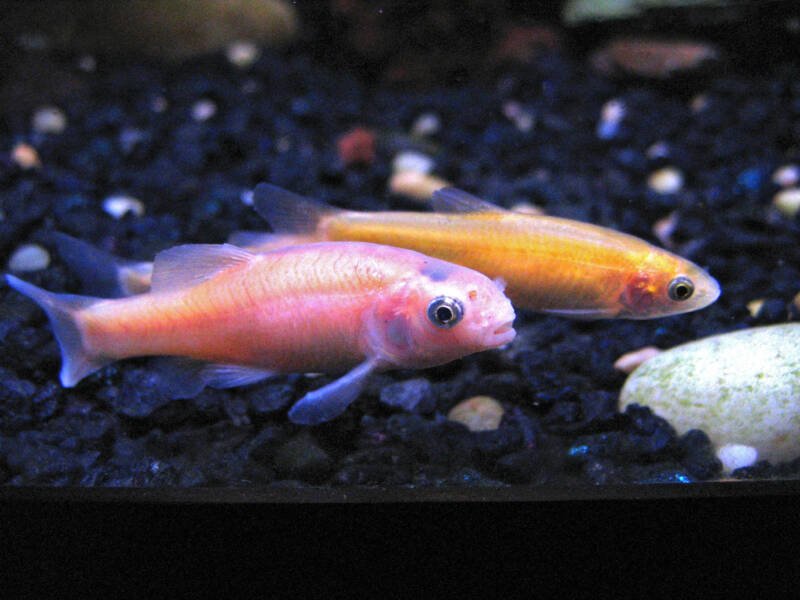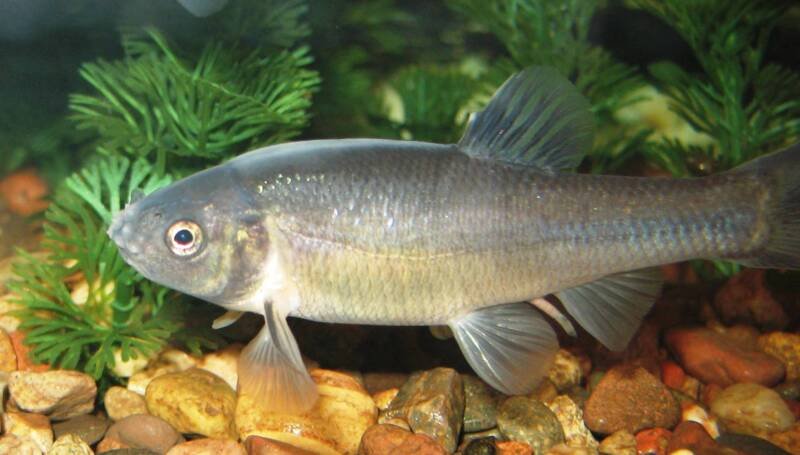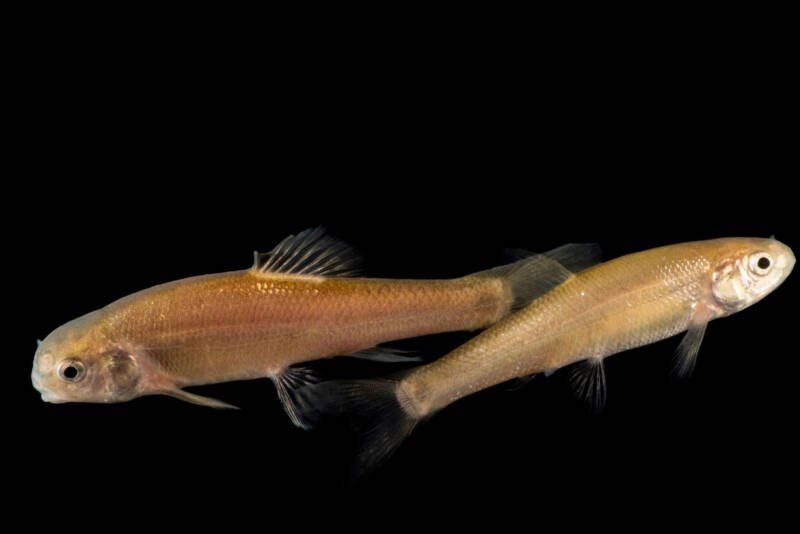Rosy red minnows are a beautiful and relatively easy addition to any community tank, as well as a popular choice for an easy-to-care-for pet.

Whether you’re a beginner or a pro, these fish are a wonderful choice that can be easy to overlook thanks to their status as feeder fish.
In this guide, we’ll take a look at what you need to know about rosy red minnows to get the very most from them and to ensure that they are happy and healthy in your tank.
The Basics
- Scientific Name: Pimephales promelas
- Known as: Rosy Red minnow, Fathead minnow, Feeder fish, Baitfish, Blackhead minnow, Red top minnow
- Care Level: Very easy
- Size: 2-4 inches
- Temperature: 50-78°F
- pH: 6-8
- Water Hardness: Soft to hard
- Minimum Thank Size: 10 gallons
- Lifespan: 1-3 years
- Origin: North America
In this article
Appearance
Rosy red minnows are small, reddish fish. Despite the name, they are not vibrant, firebox red, as you might expect. Rather, they are a somewhat orangey hue, with slight blue highlights.
What’s also perhaps surprising is that not all rosy red minnows are red! They can also come in other colors, further making the title something of a misnomer!
You’ll find “red minnows” may also be orange, pink, or even golden! These gold varieties – and even some of the pinker versions – can sometimes look a lot like goldfish.
The red coloring of the rosy red minnow actually comes from selective breeding of the fathead minnow – a breed of North American fish.

The fathead minnow is technically known as the Pimephales promelas, so that is what you would call the red minnows too!
Rosy red minnows are fairly small, growing no more than 2-4 inches. Females are generally smaller than males.
The body of this fish is very slender. The head is dorsally flattened, with round eyes on either side. The fins are translucent, while the snout is blunt.
They can live up to 3 years with proper care.
Many people will actually buy these fish as feeder fish, not quite appreciating just how beautiful or fascinating they are.
Don’t think of them just as food, but rather as full-time residents!
Behavior

Rosy red minnows are peaceful and pleasant fish. They enjoy living in groups of 4-6, and they are very social with other fish.
The only aggression these fish are likely to show is when they are ready to breed. At this point, males may challenge one another, which can lead to fighting.
Males ready for breeding will often claim a cave or overhang in the tank and will begin to clean the area.
At this point, the males will start to develop fatty tissue and breeding tubercles on the top of their heads.
In general, these fish enjoy caves and hiding, and so you should make sure to provide them with ample space to do this.
Try to include a few different rocks and stones that your fish can use in their tanks, and this will ensure they are happy and able to engage in their normal behaviors.
Rosy red minnows are also very clean fish and don’t create a lot of mess. This means that any type of filtration is likely to be suitable.
You can use a hang on back filter or a sponge filter to keep the tank clean.
However, sponge filters are a preferable choice as they will also aerate the tank and are safer for the fry.
Despite their small size, rosy red minnows are very intelligent, and each has its own personalities.
You will begin to see them engage in their own amusing behaviors, and they can be a lot of fun to watch!
Caring for Rosy Red Minnows
As mentioned, these fish are often sold as feeders to other fish. As such, they can often be kept in poor conditions.
This is a problem, as it can lead to the fish becoming sickly, which then may lead to an infection in your tank that could spread to other fish.
While this is true, though, it’s also true that these are generally very hardy fish.
Again, owing to their status, they can sometimes be treated a little heavy-handedly by stores. Despite this, they often thrive nevertheless!
Actually, rosy red minnows are found in lakes, ponds, and rivers natively.
Thus, they actually enjoy freshwater conditions but can survive in a host of other extreme conditions that would prove troublesome for other species.
You will find that rosy red minnows can survive in most water conditions: in waters with deficient oxygen levels, varying pH levels, and high salt content!
They have been found in waters that are freezing and waters that are above 100 °F!
As you might expect then, they are relatively easy to care for, as well as being adaptable to the conditions needed for your other fish.
Another handy feature of red minnows that makes them a great choice for your home aquarium is that they are known to survive well in very crowded tanks.
While all this is true, there is a difference between surviving and thriving.
Tank setup
Optimal conditions for your fish are between 50-70°F. This helps to encourage breeding.
They also prefer a larger tank of at least 10 gallons. Ensure that the tank has various hiding places for them to sneak around in (ideally rocky).
And of course, as with any fish, you should ensure that the water quality is high. Ideally, that means a pH range between 7-8 and a temperature between 50-78°F.
If you can maintain these water conditions and water temperatures, then your fish should be very happy!
The most important tip for caring for the rosy red minnow is to make sure that you choose them carefully to begin with.
Because these are sold as feeder fish, you will often find that they come in tanks with up to 500 other fish! They will exist in very cramped conditions, with very little care and attention.
This is what can result in them becoming disease-ridden and unhealthy. They develop fungal and bacterial infections.
The key then is to make sure that you pick the right fish.
When buying these red minnows, you should look for a fish store selling them primarily as pets or for aquarium hobbyists – rather than selling them as feeder fish and keeping them in less than ideal conditions.
Alternatively, you can make sure first to quarantine the fish. This will allow you to ensure they are healthy before placing them in the tank with others.
At the same time, you should make sure to treat your minnows for parasites.
Ideally, you can breed your own rosy reds.
Tank Mates

These fish are peaceful and can live harmoniously with a host of other breeds, even in small tanks. They are typically kept in groups of 4-6.
With that said, keep in mind again that these are feeder fish: in other words, they can be lunchmeat for other fish!
Ensure that they aren’t kept with any large, carnivorous fish, or they might disappear from sight!
Good fish to socialize with your red minnows include:
- Hillstream loaches
- White cloud minnows
- Dojo loaches
- Red shiners
Try to avoid keeping these with goldfish, as they may otherwise fall victim.
Feeding Rosy Red Minnows
Fortunately, these fish are very versatile in their diet, too – not fussy eaters! You can provide them with a range of different foods, seeing as they are omnivorous.
They will, therefore, eat anything from algae – like many freshwater fish – to small insects and planktons.
They also survive well enough on fish pellets and aquarium flakes. Blood worms are also fine, as are insect larvae, tubifex, and shrimp.
Aim to feed them twice a day.
Breeding Rosy Red Minnows
To start breeding these fish, you will first need to identify which ones are male and female.
As mentioned, the females are typically slightly smaller than the males.
Whereas the males will grow from 2 to 3 inches (and rarely up to 4), the females will typically remain around 1-2 inches.
Another tip is that the male of the species has a dark head and will generally appear a bit darker in complexion.
The male occasionally sports white/gold bars located just behind the head and beneath the dorsal fin.
Likewise, you should also find that the female fish are slightly brighter in color and that they have a smaller head in particular.
The good news is that in-keeping with this fish’s generally low-maintenance status, the rosy red minnow is also very easy to breed.
This is because the female fish will spawn to a significant extent in a single season.
The fish will mature fully after six months but won’t be ready to breed until they are 1-2 years old. At this point, they can be expected to spawn some time between May and September.
To encourage this to happen, try to keep the tank’s ideal temperature (between 50-78°F).
The female will then lay as many as 400 eggs in a single sitting, which will often be on a flat surface of some kind.
The males will then act as the guardians for those eggs, ensuring they are safe after they have been fertilized.
It will now take anywhere between 4-5 days for the fish to hatch into fry.
Those fries become active after 2-3 days, and you can begin to feed them with hatched brine shrimp or infusoria.
At this point, it is a good idea to make sure that you remove the fry from the community tank with other fish; otherwise, they can eat them!
Breeding rosy red minnows is a good idea as a way to minimize the risk of parasites and illnesses.
If you order a large number of fish and you are worried about contaminating your pool, keep them separately, and in a short amount of time, you are likely to have some fresh little ones soon!
Rosy Red Minnows in Pond
Rosy reds are also popular for use in ponds. They are very favored when kept with other fish, such as fancy goldfish or koi. This helps to keep those fish more active and less cautious.
They can also provide a supply of food for some larger fish, which is a natural option.
As a bonus, rosy reds will also eat goldfish and koi pellets and are good at keeping the growth of insect larvae at bay.
Finally, many people will add red minnows when there simply isn’t enough space for goldfish, koi, or guppies!
As pond fish, they are excellent dither fish thanks to their peaceful temperaments. And thanks to their hardiness, you don’t need to worry about them.
In fact, rosy red minnows are even active during the winter when the pond freezes over!
In a pond, this species is a natural prey for frogs and several other animals like snakes, orfes, and turtles. Try to keep these in check if you want to protect your rosy reds.
That said, a little bit of natural predation may be no bad thing.
Remember, we said that these fish were easy to breed? Well, in some cases, they can be a little too easy, which can result in your pond quickly becoming overrun by Pimephales promelas!
If you do have too many of these fish, then you can use traps to get them back out.
Closing Thoughts
To conclude, then, there is an awful lot to love about rosy red minnows!
These fish are often sold as feeder fish, which means that many people struggle to appreciate them for their own qualities.
Of course, they do make excellent feeder fish, and that is a great reason to invest.
But at the same time, these fish are also naturally beautiful with a rosy color and a healthy sheen.
They even come in a variety of different colors, which can add a little variety to your tank.
They have cute personalities, and most of all, they are extremely easy to look after. This latter fact makes them an excellent choice for those new to the hobby.
You will find that rosy red minnows can survive in most water conditions and even most temperatures.
And because these fish are so easy to breed, you can also easily make more.
In fact, these fish are so hardy that they are becoming increasingly popular in ponds. They work extremely well as dither fish to keep your goldfish and others more active.
They’ll even continue to move when the water freezes over! You can feed them a variety of foods as well.
The only caveat and concern is the source that you get your minnows from.
As long as you quarantine new fish that you bought as feeders or breed your own, this won’t be an issue!